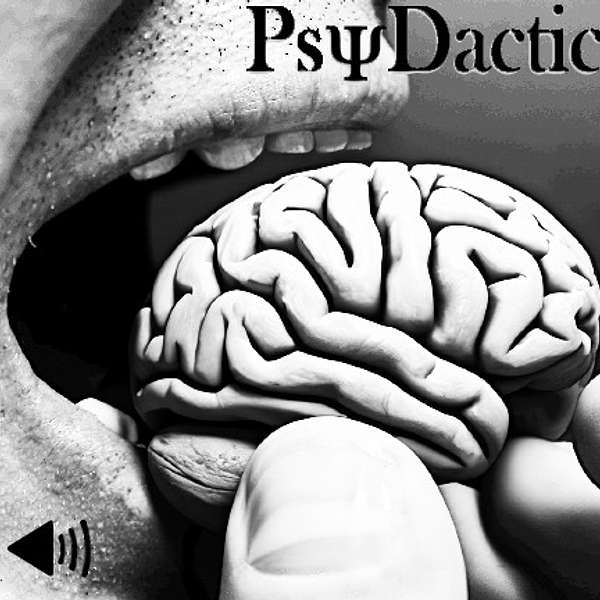
PsyDactic
A resource for psychiatrists and other medical or behavioral health professionals interested in exploring the neuroscientific basis of psychiatric disorders, psychopharmacology, neuromodulation, and other psychiatric interventions, as well as discussions of pseudoscience, Bayesian reasoning, ethics, the history of psychiatry, and human psychology in general.
This podcast is not medical advice. It strives to be science communication. Dr. O'Leary is a skeptical thinker who often questions what we think we know. He hopes to open more conversations about what we don't know we don't know.
Find transcripts with show-notes and references on each episodes dedicated page at psydactic.buzzsprout.com.
You can leave feedback at https://www.psydactic.com.
The visual companions, when available, can be found at https://youtube.com/@PsyDactic.
PsyDactic
Neuronal Networks: The Default Mode Network
Behaviors are complex. We have networks of neurons functioning in systems, some of which ramp other systems up, and some of which dampen others down. This ballet of correlation (when increased activity in one network predicts increased activity in another) and anticorrelation (when increased activity in one network predicts decreased activity in another) can help us to understand what is going on in the brains of humans who qualify for psychiatric diagnoses, and can help us to develop better targeted treatments that will predictably increase activity in select areas of the brain. Today I discuss a single networking hub in the brain: the default mode network.
Please leave feedback at https://www.psydactic.com or send any comments to feedback@psydactic.com.
References and readings (when available) are posted at the end of each episode transcript, located at psydactic.buzzsprout.com. All opinions expressed in this podcast are exclusively those of the person speaking and should not be confused with the opinions of anyone else. We reserve the right to be wrong. Nothing in this podcast should be treated as individual medical advice.
Welcome to PsyDactic - Residency Edition. I am Dr. Thomas O’Leary, or T. Ryan O’Leary as I am more commonly known, a third year psychiatry resident in the National Capital Region. This podcast is my endeavor to help myself take a deeper look into the human mind, what we do as psychiatrists, and why we do it. It is my own opinion and should not be mistaken for medical advice or for anyone or any institution's opinion. I am often wrong, or mistaken, so take what I say here with a couple pinchs of salt. Today’s episode is the start of a series on Brain Networks. References can be found at the end of the show transcript located at psydactic.buzzsprout.com.
More and more neuroscientists are teasing apart how the brain works and it's not simple. In order to find out what each part of the brain does, we used to have to damage it, either intentionally or unintentionally (like when a stroke destroys the tissue there vs when a lobotomy takes a chunk out of your frontal lobe). By noting what functions were lost, researchers were able to make a crude map of what different areas of the brain do.
But behaviors are complex. One does not simply move one’s arm. We respond to some external or internal stimuli that motivates us to decide to move an arm, and then we execute the action, generally for some reason. If our arm moves for no identifiable reason, then this is a problem. After executing an action, we decide if the outcome is satisfactory or not. During this whole process we are also dealing with our feelings, like a pain in the shoulder, a memory of having lifted the object before, a tinge of guilt that we didn’t rinse that plate and stick it into the dishwasher before the spaghetti sauce hardened into an epoxy.
All these things, these thoughts, need to be dealt with, and somehow, our brain has to decide what to give its attention to and what to think and feel about it. We have networks of neurons functioning in systems, some of which ramp other systems up, and some of which dampen others down. This ballet of correlation (when increased activity in one network predicts increased activity in another) and anticorrelation (when increased activity in one network predicts decreased activity in another) can help us to understand what is going on in the brains of humans who qualify for psychiatric diagnoses, and can help us to develop better targeted treatments that will predictably increase activity in select areas of the brain.
Today I want to discuss a single networking hub in the brain: the default mode network. In future episodes I’ll explore the interplay of other networks in the brain (like the Salience Network and the Dorsal Attention Network) that function together to help us decide what to pay attention to and how to react to that stimuli (or not react to that stimuli). In future episodes, I will discuss in more excruciating detail how the brains of humans reporting criteria of certain psychiatric disorders differ in their networking from those that do not report psychiatric symptoms.
But for now, just imagine you have just entered a quiet room with nothing in it but a soft pillow in the center. You sit on that pillow, you close your eyes, and you become aware primarily of your own thoughts. You have just ramped up parts of your default mode network.
The discovery of the Default Mode Network seems to be traced in large part to Raichle (RAY-kl) and colleages and was first published about in 2001. The primary author, Marcus Raicle, also wrote a paper in the Annual Review of Neuroscience 2015.38:433-447 called “The Brain’s Default Mode Network,” describing how it was discovered, and what we knew about it up to that point.
In summary, neuroscientists used to take resting state scans (PET and fMRIs) of the brain before making people do a task, and then they would take a scan of that same brain during or after a particular task. I’ll quote Raichle here, <<QUOTE>> “At some point in our work, and I do not recall the motivation, I began to look at the resting-state scans minus the task scans. What immediately caught my attention was the fact that regardless of the task under investigation, the activity decreases almost always included the posterior cingulate and the adjacent precuneus.” <<UNQUOTE>> This meant that when a brain started a task, it dampened down a predictable part of the brain: that part being the posterior cingulate gyrus, the part of the precuneus right next to it.
If you were to take a brain and wrap your hands around the two lobes, then split it apart, you would have a clear view of the medial prefrontal cortex, the precuneus, and the cingulate gyrus which is hugging the corpus callosum. The cingulate gyrus is described as part of the limbic system, but it also talks to regions of the brain in the cortex down to the spinal chord. The cingulate gyrus is amazing. The more anterior parts play a huge role in emotional regulation. The middle part is intimately involved with the reward centers of the brain. The posterior part is active in visio-spatial orientation and memory processing. Over all, it does a lot of tasks that have been crucial for humans and our ancestors deep into evolutionary time.
It just so happens that the rear or posterior part of the cingulate gyrus butts up against a region of the brain just superior to it on the medial parietal lobe called the precuneus. The precuneus also has been shown to play crucial roles in understanding visio-spatial relationships, in activating episodic and semantic memories, and in contributing to our sense of self… a sense that we have our own agency. It is a self-referential area… one part of our identity system. The default mode network is especially concerned with thinking about ourselves. In the precuneus, the anterior part seems to be more involved in the visio-spatial, self-referencial, and consciousness making tasks, and the posterior part seems to be more involved in memory activation, similar to the neighboring part of the cingulate gyrus.
Another area of the brain also is activated when humans stop engaging in designated tasks and start just thinking, especially about themselves: the medial prefrontal cortex.The mPFC is intimately linked with our memories, emotions, and senses, and is likely important for linking our past with our recent present. It is also crucial for determining how we feel about what’s happening to us and how we place ourselves in a social context. That makes the mPRC crucial for how we plan for future action.
Together, the PCC, the precuneus, and the mPFC form the bulk of our default mode network, but other parts of the brain are involved too. More complete list includes the ventral medial prefrontal cortex, the dorsal medial prefrontal cortex, the posterior cingulate cortex and adjacent precuneus, and the lateral parietal cortex. This is the network that most obviously engages when we are able to relax and focus on ourselves, put ourselves in the context of our past, put ourselves in the context of ourselves.
Within the mPFC, the vmPFC seems to link our senses with our emotions in a complex way that often involves a social context. It is critical for determining our personality, regulating emotions, and dealing with anxiety. One part of this area described as the agranular, subgenual portion of the vmPFC has been shown to play a large role in mood disorders and stimulating this area with implanted electrodes has been effective in treating intractable depression. The dmPFC, a little farther back, seems to be more important for answering questions like “do I like this or not?”, “what does that mean to me?”
Raichle summarizes it like this: “data from humans suggest that the default mode network instantiates processes that support emotional processing (VMPC), self-referential mental activity (DMPC), and the recollection of prior experiences (posterior elements of the default mode network)”
It is tempting to think and I think commonly misunderstood that the DMN turns off when we are not engaged in deep thinking or what neuropsychologists call “spontaneous cognition,” but this is not the case. It seems to be always functioning, but different parts of it are functioning at different levels at different times. For example, the lateral parietal portion demonstrates much greater connectivity to the hippocampus in the evening that it does immediately after a good night's sleep. When other areas of the brain turn on, parts of the default mode network may tone down a bit. This correlation and anticorrelation is likely a crucial process in many mental disorders. Also, the default mode network still exhibits significant function when people are not fully conscious of their thoughts, when they are not daydreaming, such as when they are under anesthesia or in early stages of sleep. The DMN seems to be a critical part of the mammalian brain, and it is not likely that other mammals spend as much time in self-referential ponderings as humans do.
In future episodes, I want to get into more of the research on how the DMN interacts with the rest of the brain. It may even give us insight into why some people respond to medicines versus psychotherapy and others do not respond to anything.
I am Dr. O, and this has been an episode of PsyDactic Residency Edition. 1 2
Bibliography
1. Raichle ME. The brain’s default mode network. Annu Rev Neurosci. 2015;38:433-447. doi:10.1146/annurev-neuro-071013-014030
2. Uddin LQ, Kelly AM, Biswal BB, Castellanos FX, Milham MP. Functional connectivity of default mode network components: correlation, anticorrelation, and causality. Hum Brain Mapp. 2009;30(2):625-637. doi:10.1002/hbm.20531
Podcasts we love
Check out these other fine podcasts recommended by us, not an algorithm.

Mindhunting: Journeys in Forensic Psychiatry
Dr Michael Schirripa
Brain Science with Ginger Campbell, MD: Neuroscience for Everyone
Ginger Campbell, MD
